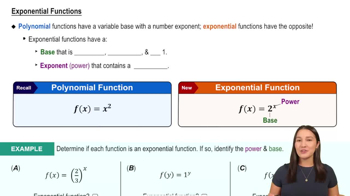Table of contents
- 0. Functions7h 52m
- Introduction to Functions16m
- Piecewise Functions10m
- Properties of Functions9m
- Common Functions1h 8m
- Transformations5m
- Combining Functions27m
- Exponent rules32m
- Exponential Functions28m
- Logarithmic Functions24m
- Properties of Logarithms34m
- Exponential & Logarithmic Equations35m
- Introduction to Trigonometric Functions38m
- Graphs of Trigonometric Functions44m
- Trigonometric Identities47m
- Inverse Trigonometric Functions48m
- 1. Limits and Continuity2h 2m
- 2. Intro to Derivatives1h 33m
- 3. Techniques of Differentiation3h 18m
- 4. Applications of Derivatives2h 38m
- 5. Graphical Applications of Derivatives6h 2m
- 6. Derivatives of Inverse, Exponential, & Logarithmic Functions2h 37m
- 7. Antiderivatives & Indefinite Integrals1h 26m
- 8. Definite Integrals4h 44m
- 9. Graphical Applications of Integrals2h 27m
- 10. Physics Applications of Integrals 2h 22m
1. Limits and Continuity
Finding Limits Algebraically
Problem 80b
Textbook Question
Find the vertical asymptotes. For each vertical asymptote x=a, analyze lim x→a^− f(x) and lim x→a^+f(x).
f(x)=3e^x+10 / e^x
 Verified step by step guidance
Verified step by step guidance1
Step 1: Identify the form of the function f(x) = \frac{3e^x + 10}{e^x}. This is a rational function where the numerator is 3e^x + 10 and the denominator is e^x.
Step 2: Determine where the denominator is zero, as vertical asymptotes occur where the function is undefined. Set e^x = 0 and solve for x. However, e^x is never zero for any real number x, so there are no vertical asymptotes from the denominator being zero.
Step 3: Simplify the function if possible. Notice that f(x) = \frac{3e^x + 10}{e^x} can be rewritten as f(x) = 3 + \frac{10}{e^x}.
Step 4: Analyze the behavior of f(x) as x approaches positive and negative infinity. As x → ∞, e^x → ∞, so \frac{10}{e^x} → 0, and f(x) approaches 3. As x → -∞, e^x → 0, so \frac{10}{e^x} → ∞, and f(x) approaches ∞.
Step 5: Conclude that there are no vertical asymptotes for this function, but there is a horizontal asymptote at y = 3 as x approaches positive infinity.
 Verified video answer for a similar problem:
Verified video answer for a similar problem:This video solution was recommended by our tutors as helpful for the problem above
Video duration:
1mPlay a video:
Was this helpful?
Key Concepts
Here are the essential concepts you must grasp in order to answer the question correctly.
Vertical Asymptotes
Vertical asymptotes occur in a function when the output approaches infinity as the input approaches a certain value from either the left or the right. This typically happens when the function is undefined at that point, often due to division by zero. Identifying vertical asymptotes involves finding values of x that make the denominator zero while ensuring the numerator is not also zero at those points.
Recommended video:

Introduction to Cotangent Graph Example 1
Limits
Limits are fundamental in calculus, representing the value that a function approaches as the input approaches a certain point. In the context of vertical asymptotes, we analyze the left-hand limit (as x approaches a from the left) and the right-hand limit (as x approaches a from the right) to determine the behavior of the function near the asymptote. This helps in understanding whether the function tends to positive or negative infinity.
Recommended video:

One-Sided Limits
Exponential Functions
Exponential functions, such as f(x) = 3e^x + 10 / e^x, involve a constant base raised to a variable exponent. These functions exhibit rapid growth or decay, depending on the base and the exponent's sign. Understanding the behavior of exponential functions is crucial for analyzing limits and asymptotic behavior, especially since they can dominate polynomial or rational functions in terms of growth rates.
Recommended video:

Exponential Functions

 5:21m
5:21mWatch next
Master Finding Limits by Direct Substitution with a bite sized video explanation from Callie
Start learningRelated Videos
Related Practice







